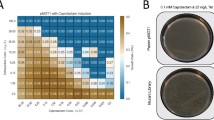Summary
ThekorA andkorB loci ofStreptomyces lividans plasmid pIJ101 have previously been shown to control expression of the pIJ101tra (formerlykilA) andkilB genes at the transcriptional level. We show here that mutations in translational open reading frames (ORFs) that map within the kor loci abolish repression of theS. lividans lac gene directed by thetra andkilB promoters. Introduction of thekorA andkorB ORFs intoEscherichia coli maxicells under control of anE. coli promoter gave rise to 31 kDa and 10 kDa proteins that correspond in size to the products expected from the sequences of the respective ORFs; these proteins controlled transcription from the pIJ101tra andkilB promoters in theE. coli host. Mutations that affected the KorA or KorB phenotype altered the structure of, or eliminated, the protein products of thekorA andkorB ORFs, further demonstrating that these ORFs encode the functional repressors of the pIJl01kil/kor gene system.
Similar content being viewed by others
References
Amann E, Brosius J, Ptashne M (1983) Vectors bearing a hybridtrp-lac promoter useful for regulated expression of cloned genes inE. coli. Gene 25:167–178
Beck E, Sommei R, Auerswald EA, Kulz CH, Zink B, Osterbuig G, Schallerg H (1978) Nucleotide sequence of bacteriophage fd DNA. Nucleic Acids Res 5:4495–4503
Bibb MJ, Ward JM, Hopwood DA (1978) Transformation of plasmid DNA intoStreptomyces plasmids at high frequency. Nature 274:398–400
Bibb MJ, Bibb MJ, Ward JM, Cohen SN (1985) Nucleotide sequence encoding and promoting expression of three antibiotic resistance genes indigenous toStreptomyces. Mol Gen Genet 199:26–36
Bibb MJ, Janssen GR, Ward JM (1986) Cloning and analysis of the promoter region of the erythromycin resistance gene (ermE) ofStreptomyces erythraeus. Gene 41: E357-E368
Buttner MJ, Brown NL (1987) Two promoters from theStreptomyces plasmid pU101 and their expression inEscherichia coli. Gene 51:179–186
Buttner MJ, Smith AN, Bibb MJ (1988) At least three different RNA polymerase holoenzymes direct transcription of the agarase gene (dagA) ofStreptomyces coelicolor A3(2). Cell 52:599–607
Calhoun DH, Gray JE (1981) Detection of proteins coded by cloned DNA segments. Focus 3:1–11
Casadaban MJ, Cohen SN (1980) Analysis of gene control signals by DNA fusion and cloning inEscherichia coli. J Mol Biol 138:179–207
Cohen SN, Chang ACY (1977) Revised interpretation of the origin of the pSC101 plasmid. J Bacteriol 132:734–737
Cohen SN, Chang ACY, Hsu L (1973) Nonchromosomal antibiotic resistance in bacteria: Genetic transformation ofEscherichia coli by R-factor DNA. Proc Natl Acad Sci USA 69:2110–2114
Deng ZT, Kieser T, Hopwood DA (1986) Expression of aStreptomyces plasmid promoter inEscherichia coli. Gene 43:295–300
Eckhardt T, Strickler J, Gorniak L, Burnett WV, Fare LR (1987) Characterization of the promoter, signal sequence and amino terminus of a secreted β-galactosidase fromStreptomyces lividans. J Bacteriol 169:4249–4256
Gentz R, Langner A, Chang ACY, Cohen SN, Bujard H (1981) Cloning and analysis of strong promoters is made possible by the downstream placement of a RNA termination signal. Proc Natl Acad Sci USA 78:4936–4940
Hopwood DA, Bibb MJ, Chater KF, Kieser T, Bruton CJ, Kieser HM, Lydiate DJ, Smith CP, Ward JM, Schrempf H (1985) Genetic manipulation ofStreptomyces: a laboratory manual. The John Innes Foundation, Norwich, England
Janssen GR, Ward JM, Bibb MJ (1989) Unusual transcriptional and translational features of the aminoglycoside phosphotonuclease gene (aph) fromStreptomyces fundiae. Genes Dev 3:415–429
Jaurin B, Cohen SN (1984)Streptomyces lividans RNA polymerase recognizes and usesEscherichia coli transcriptional signals. Gene 28:83–91
Jaurin B, Cohen SN (1985)Streptomyces containsEscherichia coli-type A+T-rich promoters having novel structural features. Gene 39:191–201
Kendall KJ, Cohen SN (1987) Plasmid transfer inStreptomyces lividans: identification of akil-kor system associated with the transfer region of pIJ101. J Bacteriol 169:4177–4183
Kendall KJ, Cohen SN (1988) Complete nucleotide sequence of theStreptomyces lividans plasmids pIJ101 and correlation of the sequence with genetic properties. J Bacteriol 170:4634–4651
Kieser T, Hopwood DA, Wright HM, Thompson CJ (1982) pIJ101, a multi-copy broad host-rangeStreptomyces plasmid: functional analysis and development of DNA cloning vectors. Mol Gen Genet 185:223–238
Klock G, Hillen W (1986) Expression, purification and operation binding of the transposon Tr1721-encloded Ter repressor. J Mol Biol 189:633–641
Lago BD, Streicher SL (1982) The new genetics of streptomycetes. ASM News 48:53–57
Maniatis T, Fritsch EF, Sambrook J (1982) Molecular cloning: a laboratory manual. Cold Spring Harbor Laboratory, Cold Spring Harbor, New York
Miller J (1972) Experiments in molecular genetics. Cold Spring Harbor Laboratory, Cold Spring Harbor, New York
Oka A, Sugisaki H, Takanami M (1981) Nucleotide sequence of the kanamycin resistance transposon Tn903. J Mol Biol 147:217–226
Pabo CO, Sauer RT (1984) Protein-DNA recognition. Annu Rev Biochem 53:293–321
Peczynska-Czoch W, Mordarski M (1988) Actinomycete enzymes. In: Goodfellow M, Williams ST, Mordarski M (eds) Actinomycetes in biotechnology. Academic Press, London, pp 220–257
Ptashne M, Backman K, Humayun MZ, Jeffrey A, Maurer R, Sauer RT (1976) Autoregulation and function of a repressor in bacteriophage lambda. Science 104:156–161
Rosenberg M, Court D (1979) Regulatory sequences involved in the promotion and termination of transcription. Annu Rev Genet 13:319–353
Sancar A, Hack AM, Rupp WD (1979) A simple method for identification of plasmid-coded proteins. J Bact 137:692–693
Stein DS, Kendall KJ, Cohen SN (1989) Identification and analysis of transcriptional regulatory signals for thekil andkor loci ofStreptomyces plasmid pUl01. J. Bact. 171: 5768–5775
Ward JM, Janssen GR, Kiesic T, Bibb MJ, Buttner MJ, Bibb MJ (1986) Construction and characterization of a series of multicopy promoter-probe plasmid vectors forStreptomyces using the aminoglycoside phosphotransferase from Tn5 as indicator. Mol Gen Genet 203:468–478
Westpheling J, Ranes M, Losick R (1985) RNA polymerase heterogeneity inStreptomyces coelicolor. Nature 313:22–27
Author information
Authors and Affiliations
Additional information
Communicated by W. Goebel
Rights and permissions
About this article
Cite this article
Stein, D.S., Cohen, S.N. Mutational and functional analysis of thekorA andkorB gene products ofStreptomyces plasmid p1J101. Mol Gen Genet 222, 337–344 (1990). https://doi.org/10.1007/BF00633838
Received:
Issue Date:
DOI: https://doi.org/10.1007/BF00633838




